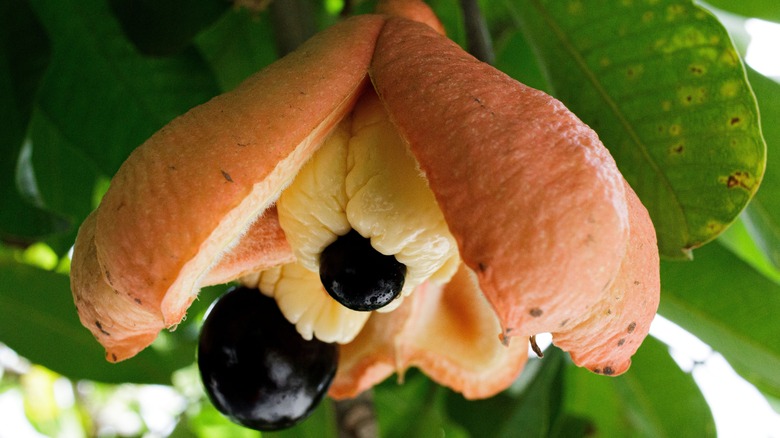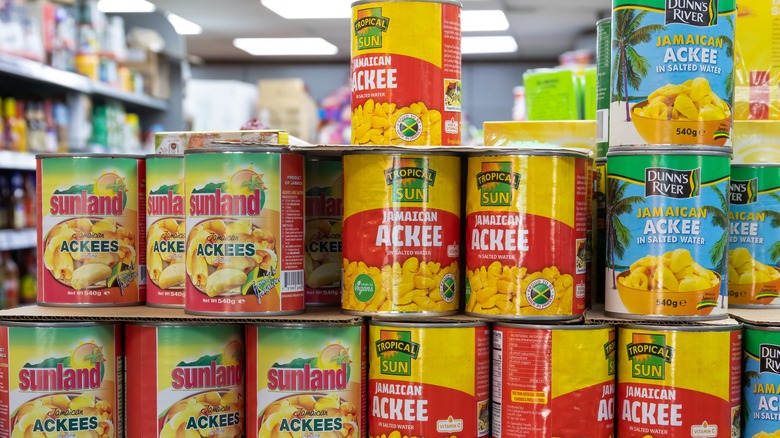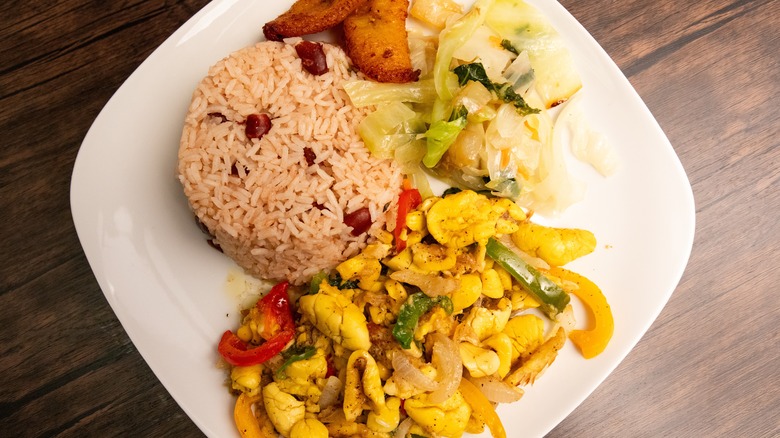The Reason Ackee Fruit Is Banned In The US
The ackee fruit (Blighia sapida) clearly lets you know when it is ready to be eaten. Unlike most fruits that make you look for clues or use tricks (like this 2-finger trick for watermelons) to check their readiness for consumption, a ripened ackee splits open, revealing cream-colored edible flesh and a large, shiny black seed inside its bright yellow-red covering. It's a good thing the fruit provides such a clear signal of when it's ready because unripe ackee is toxic. Even when ripe, only the chunks of inner flesh (called arils) are edible while the skin and seed contain dangerously high levels of a toxin called hypoglycin A. Unlike the notorious durian which is only banned in certain places due to its smell, fresh ackee fruit is banned throughout the U.S. because of the potential of consuming the poisonous bits.
Native to West Africa, the ackee fruit (also called achee, ackee apple, and vegetable brain) was introduced in Jamaica in the 1770s by the country's first botanist, Dr. Thomas Clarke, through seeds brought over in a West African slave ship. The fruit quickly became popular in the island nation and as Jamaica's national fruit, is used to make the country's national delicacy — ackee and saltfish. Despite spreading to South and Central American and Caribbean countries (and even parts of South Florida), the fruit remains relatively obscure. While fresh ackee is banned, it is possible to find preserved or processed varieties, which are let into the U.S. after passing safety regulations set by the FDA.
Ackee fruit can be toxic when not eaten correctly
In West African and Central American countries where it is traditionally eaten, ackee fruit is allowed to ripen on the tree and only when it has split open on its own is it harvested. Raw ackee contains high amounts of hypoglycin A in all its parts — about ten times the level considered safe to consume. Consumption above safe levels of hypoglycin A can sometimes have no effect, and in other instances lead to vomiting, seizures, coma, and even death. According to a study published in StatPearls, it is difficult to predict how a person may react to high levels of hypoglycin A. Adverse symptoms experienced after consuming ackee are sometimes referred to as Jamaican vomiting sickness.
There are two types of ackee fruit — the softer variety is called butter ackee and has slightly yellower arils while the firmer variety is called cheese ackee. As it ripens, the concentration of hypoglycin A reduces in the arils, making these fleshy parts safe to eat. However, the seed, its red membrane, and the fruit's skin remain toxic, even once it's ripened and should be carefully handled and washed thoroughly before eating. The fruit must ripen naturally to be fit to eat and even cooked ackee that is not fully ripe can be dangerous.
Still want to eat ackee? Here's what you should know
Ackee imports from Jamaica were banned by the FDA in the 1970s but once simpler methods to detect hypoglycin A in ackee were discovered, canned varieties of the fruit became available in the U.S. You still cannot buy it fresh and will have to settle for ripe ackee arils in brine. Frozen, dried, and pulped versions of the fruit are also available. All ackee products are only imported once their manufacturers have passed stringent FDA checks to ensure they are packaging safe ackee with acceptable levels of hypoglycin A.
Ackee flesh turns tender when cooked and takes on a yellow hue, with many comparing the look and texture of cooked ackee to scrambled eggs. It has a subtle, bitter flavor with nutty notes and is generally eaten in savory dishes. However, the mild, nutty flavor makes it quite versatile and easy to use in desserts, not unlike the bright purple ube.
The famous Jamaican dish ackee and saltfish, traditionally eaten around breakfast time, is made using ackee, dehydrated salted cod, peppers, onions, tomatoes, and spices. The arils are gently boiled to tenderize them but it's important not to overcook them into mush. Instead, the fruit is best enjoyed as delicate morsels accompanied by dishes with strong or punchy flavors. If sampling dangerous fruit is your jam, ackee can easily be substituted into an existing recipe from your repertoire.


